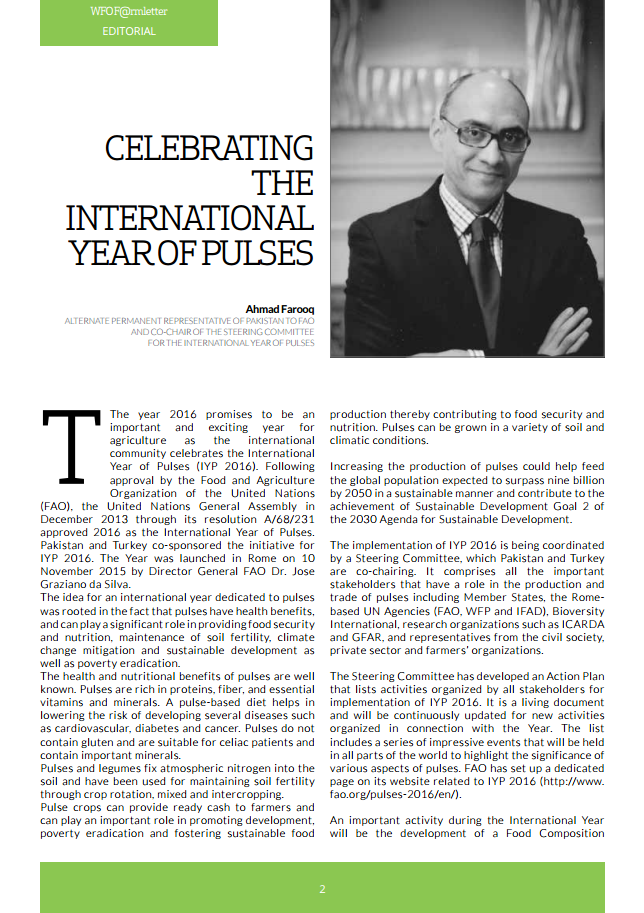- Details
Mr. Ahmad Farooq, Alternate Permanent Representative of Pakistan to FAO, and the co-chair of the steering committee for the International Year of Pulses, has written a great editorial outlining the year.
Read the full article in the WFO F@rmletter e-magazine.
- Details
Assistant Minister for Agriculture and Water Resources, Senator Anne Ruston, has welcomed the International Year of Pulses 2016 as a chance for all Australians to discover more about the valuable contribution these crops make to agriculture and our economy.
Minister Ruston recognised the importance of the year and the industry at an industry gala dinner in Melbourne last night.
“Australia’s pulse industry is going from strength to strength, and we are certainly proud to be recognised as one of the world’s biggest exporters,” Minister Ruston said.
“Many would not know that Australia is actually the largest exporter of faba beans and chickpeas in the world, and the 2015-16 forecast signals a 56 per cent growth in our export earnings for chickpeas.
“The Coalition Government continues to pursue the best possible market access opportunities for Australian pulse producers, recently finalising an agreement for lupins to India and the resumption of lentil trade to Saudi Arabia—and we also continue to work on free trade agreements with India and Indonesia.
“Under the Package Assisting Small Exporters programme, the Grain Industry Association of Western Australia received a $130,000 grant to develop an export market strategy for lupins to Saudi Arabia and the United Arab Emirates.
“Pulses, which include chickpeas, faba or broad beans, field peas, lentils, lupins and mung beans, are not only valuable crops in their own right, but they’re also great for the soil, where they fix nitrogen and contribute to soil fertility so are beneficial in crop rotation.
“For farmers pulses are extremely valuable crops which can lower input costs and dramatically reduce stubble borne wheat diseases like crown rot as well as providing animal feed.
“For the consumer, they’re a low fat source of protein with high fibre, vitamins and minerals with a low glycaemic index which have been shown to help prevent diseases like cancer, diabetes and heart disease.”
The United Nations launched the International Year of Pulses 2016 in November 2015. The government, through its agriculture Minister-Counsellor in Rome, is supporting the industry’s efforts engaging the UN Food and Agriculture Organization, which oversees the international year.
For more information: www.fao.org/pulses-2016
Media contact
Ashton Hurn, 0476 849 100
- Details
This article originally appeared on the IFPRI Blog.
Written by Grace Lerner.
The United Nations General Assembly declared 2016 the International Year of the Pulses. To mark the year, IFPRI spoke with P.K. Joshi, IFPRI’s Director for South Asia, about pulses. Joshi has been supporting the CGIAR Research Program on Agriculture for Nutrition and Health (A4NH) research portfolio on pulses since 2012.
What is a pulse? What are the benefits?
Pulses are food commodities from the legume family. Pulses are high in protein and low in fat, rich in some vitamins and minerals. In most developing countries pulses are being used as food, but in developed countries, like the United States, Canada, or Australia, it is also used as animal feed. Pulses also improve soil health. They fix atmospheric nitrogen in their roots and improve soil health by enriching nitrogen. Once the crop is harvested, the soil becomes richer in nitrogen. So pulses have two advantages: one is for human health, and the second is for soil health.
What percent of pulses are consumed by humans and how much is used as animal feed?
In developing countries, 80 percent of pulses are used for food. In developed countries, less than 40 percent is used for food. This means that more than 60 percent of pulses in developed countries is used for animal feed.
How many different kinds of pulses are there?
There are several out there, both major and minor crops. The major crops among pulses are the dry beans, dry peas, chick pea, cowpeas, and lentils. These five crops account for roughly 80 percent of total pulse production. There are some country-specific major crops. For example, the pigeon pea in India accounts for about 75 percent of total pigeon pea area in the world.
Can you give us a general overview of global production and consumption of pulses?
Total production of pulses in 2011 was 72 million tons. Global pulse demand has gone from 42 million tons in 1980/1981 to 66 million tons in 2011. It is important to note that, although total overall demand for pulses has increased, per capita consumption has declined.
India is the world’s top producer of pulses, and it also is the top importer. What actions are needed in India to increase the production of pulses to keep up with such demand?
India is importing around 3 to 4 million tons of pulses. This is likely to increase by 6 million tons by 2020. We have to increase our pulse production.
There are high yielding varieties available but they are confined to the research station. The private sector is not entering into the pulse seed business due to its tiny scale. Therefore, there is a need that we involve civil society organizations that work in agriculture to strengthen the seed sector. The government may be able to engage these civil society organizations in scaling-up seed production by providing incentives. We should also strengthen farmer-producer organizations and cooperatives. The Indian government can draw upon lessons from the Indian dairy sector. In the 1970s and 1980s, India had a deficit in milk production, and was importing huge quantities of milk. Today, India is number one in milk production and has even started exporting.
With the demand-supply gap expected, what can policy makers do to make sure there’s enough supply?
The Indian government has a threefold strategy. First, there is a substantial increase to the minimum support prices for pulses. Second, they are trying to take water to every field. They are planning that by 2019 a large track of agriculture land will have water for irrigation. Third, the government is considering introducing pulse insurance. Pulses are very risky in both production and marketing. The insurance is one idea to encourage farmers to take risks. But in my opinion, the three top priorities should be (1) strengthening the seed sector to increase production, (2) developing a strategic reserve to stabilize prices, and (3) introducing an attractive insurance plan to reduce risk of crop failure.
What countries are most involved in the pulse trade?
The global pulse trade is about 12 million tons. This used to be 3 million tons in 1980/1981. Eighteen percent of global pulse production is traded. Five countries account for 75 percent of all exports: Canada, Myanmar, USA, Australia and China. India, China, Bangladesh, Pakistan, and Egypt account for 62 percent of all imports.
One of the common criticisms of the Green Revolution was that it promoted staple grain crops at the expense of other more nutritious staple food crops, such as pulses. What types of advancements will allow farmers to grow more pulses for increased yields and nutrition?
I don’t buy this argument! First comes food security, nutritional security comes at the next level. Our bellies must first be full and we should not be hungry. The Green Revolution brought increases in rice and wheat production and helped developing countries to overcome some of these problems. India, for example, now has a surplus of rice and wheat and has started exporting rice. However, there was no breakthrough in pulse productivity. Global cereal yields increased from 1,500 kilograms per hectare in 1961 to 4,000 kilograms per hectare in 2013. And for pulses, in the same period, yields increased from 550 kilograms per hectare to 1,000 kilograms per hectare. Pulse yields barely doubled. The future research direction is to break through this productivity problem.
What are the major areas of pulse research in the coming years?
At IFPRI we are working on the changing prices of pulses. When there’s a fall in pulse production, prices shoot up. For example, the price of the pigeon pea in India went from 80 rupees per kilogram to over 200 rupees per kilogram in the span of about 15 days when the market recognized a drought. How do you stabilize prices for the commodities? We are working with Maximo Torero and MTID on the Indian Food Security Portal to address this. We are also analyzing the drivers for pulses production. Is it the pulse price or non-price that contribute in pulse production?
2016 is the International Year of Pulses – why is this important?
The International Year of the Pulses brings awareness to importance of pulses on a global level. The importance is not known to the majority of global consumers like it is in India. This will help increase global demand. It will help in allocating more resources to increase their production through research and improved value chain development. Pulses are also climate-smart–they improve the soil and contribute to reducing greenhouse gas emissions. Pulses are the food of the future for improved human health and sustainable agriculture systems.
- Details
Madrid, 27 de enero de 2016
 La Asociación de Legumbristas de España en colaboración con la compañía LegumeChef han llebado a Madrid Fusión al prestigioso cocinero indio Atul Kochhar, que cuenta con una estrella Michelin, para destacar la celebración en 2016 del Año Internacional de las Legumbres. Así, Attu Kochhar realizó varios platos con varios tipos de lentejas.
La Asociación de Legumbristas de España en colaboración con la compañía LegumeChef han llebado a Madrid Fusión al prestigioso cocinero indio Atul Kochhar, que cuenta con una estrella Michelin, para destacar la celebración en 2016 del Año Internacional de las Legumbres. Así, Attu Kochhar realizó varios platos con varios tipos de lentejas.
Atul Kochhar, chef de los restaurantes Benares Londres (1* estrella Michelin) y Benares Madrid, fue el protagonista de una ponencia sobre las legumbres en Madrid Fusión, de la mano de la Asociación de Legumbristas de España (ALE) y la compañía LegumeChef.
Albert García, en representación de la Asociación de Legumbristas, recordó a los presentes que la FAO ha nombrado 2016 como Año Internacional de las Legumbres para potenciar el consumo de este alimento básico, que proviene además de un cultivo sostenible y beneficioso para el suelo y el medioambiente.
Nadie mejor que Atul Kochhar para destacar este Año Internacional de las Legumbres, que son una de las bases en la cocina India. Se dice incluso que los indios miden la calidad de sus cocineros por cómo elaboran las lentejas, siendo estas un plato fundamental en cualquier casa o restaurante.
Atul Kochhar utiliza las legumbres en numerosas elaboraciones y en Madrid Fusión elaboró varios platos como una ensalada con lentejas germinadas, una sabrosa croqueta de lentejas, o un guiso de lentejas y especias de la India acompañadas con arroz, una combinación básica en la alimentación de su país. El chef hizo un recorrido por las legumbres del mundo y explicó las diferentes variedades de lentejas y otras legumbres en la cocina así como las propiedades saludables de las legumbres como su versatilidad y usos en la cocina.

